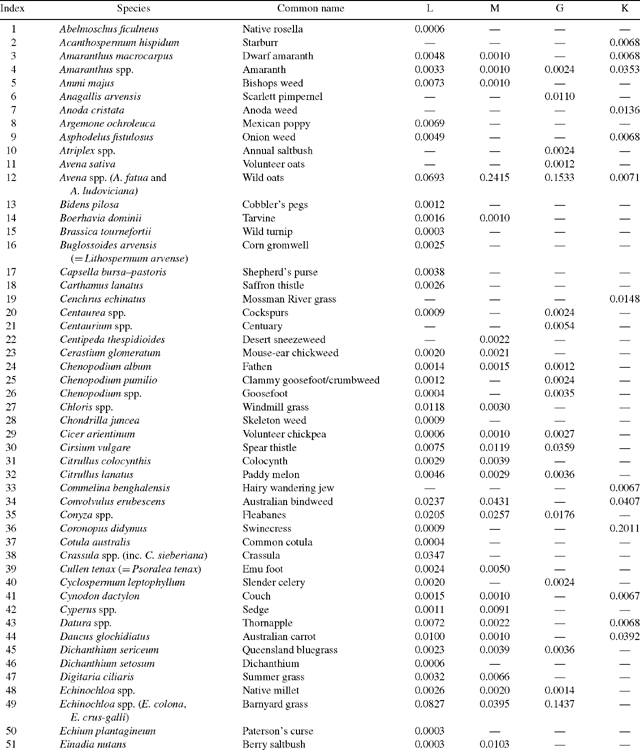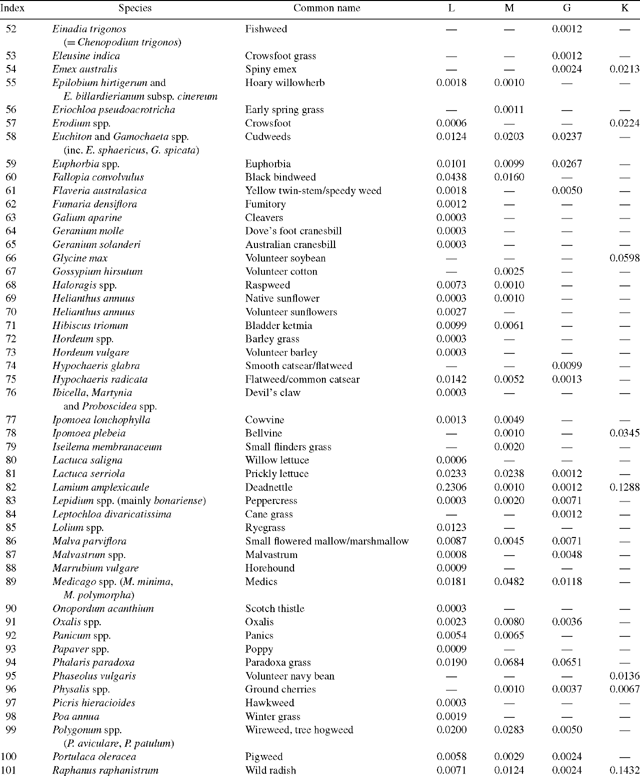Weed species richness, density and relative abundance on farms in the subtropical grain region of Australia
L. J. Rew A F , R. W. Medd B , R. Van de Ven B , J. J. Gavin A C , G. R. Robinson D , M. Tuitee E , J. Barnes E and S. Walker DA NSW Department of Primary Industries, Tamworth Agricultural Institute, Tamworth, NSW 2340, Australia.
B NSW Department of Primary Industries, Orange Agricultural Institute, Forest Road, Orange, NSW 2800, Australia.
C Present address: South Australian Department Water, Land and Biodiversity Conservation, PO Box 357, Port Augusta, SA, 5700, Australia.
D Department of Primary Industries, PO Box 2282, Toowoomba, Qld 4350, Australia.
E Primary Industries and Fisheries, PO Box 23, Kingaroy, Qld 4610, Australia.
F Corresponding author. Email: lrew@montana.edu
Australian Journal of Experimental Agriculture 45(6) 711-723 https://doi.org/10.1071/EA03273
Submitted: 20 December 2003 Accepted: 17 September 2004 Published: 29 June 2005
Abstract
Weed management is one of the most important economic and agronomic issues facing farmers in Australia’s grain regions. Weed species occurrence and abundance was monitored between 1997 and 2000 on 46 paddocks (sites) across 18 commercial farms located in the Northern Grain Region. The sites generally fell within 4 disjunct regions, from south to north: Liverpool Plains, Moree, Goondiwindi and Kingaroy. While high species richness was found (139 species or species groups), only 8 species occurred in all 4 regions and many (56 species) only occurred at 1 site or region. No species were observed at every site but 7 species (Sonchus spp., Avena spp., Conyza spp., Echinochloa spp., Convolvulus erubescens, Phalaris spp. and Lactuca serriola) were recorded on more than 70% of sites. The average number of species observed within crops after treatment and before harvest was less than 13. Species richness tended to be higher in winter pulse crops, cotton and in fallows, but overall was similar at the different sampling seasons (summer v. winter). Separate species assemblages associated with the Goondiwindi and Kingaroy regions were identified by correspondence analysis but these appeared to form no logical functional group. The species richness and density was generally low, demonstrating that farmers are managing weed populations effectively in both summer and winter cropping phases. Despite the apparent adoption of conservation tillage, an increase in opportunity cropping and the diversity of crops grown (13) there was no obvious effect of management practices on weed species richness or relative abundance. Avena spp. and Sonchus spp. were 2 of the most dominant weeds, particularly in central and southern latitudes of the region; Amaranthus spp. and Raphanus raphanistrum were the most abundant species in the northern part of the region. The ubiquity of these and other species shows that continued vigilance is required to suppress weeds as a management issue.
Acknowledgments
Many thanks to all of the farmers who collaborated with this project and to John Hosking and Andrew Storrie at Tamworth Agricultural Institute for help with plant identification. The project was funded by the Grains Research and Development Corporation with support from NSW Agriculture. Constructive comments from 2 anonymous referees helped to improve this manuscript, particularly regarding the use of correspondence analysis.
Adkins SW,
Wills D,
Boersma M,
Walker SR,
Robinson G,
McLeod RJ, Einam JP
(1997) Weeds resistant to chlorsulfuron and atrazine from the north-east grain region of Australia. Weed Research 37, 343–349.
| Crossref | GoogleScholarGoogle Scholar |

Alemseged Y,
Jones R, Medd R
(2001) A farmer survey of weed management and herbicide resistance problems of winter crops in Australia. Plant Protection Quarterly 16, 21–25.

Buhler DD
(2002) Challenges and opportunities for integrated weed management. Weed Science 50, 273–280.

Cooper JL
(1999) A grower survey of rotations used in the New South Wales cotton industry. Australian Journal of Experimental Agriculture 39, 743–755.
| Crossref | GoogleScholarGoogle Scholar |

Derksen DA,
Lafond GP,
Thomas AG,
Loeppky HA, Swanton CJ
(1993) Impact of agronomic practices on weed communities: tillage systems. Weed Science 41, 409–417.

Derksen DA,
Thomas AG,
Lafond GP,
Loeppyky HA, Swanton CJ
(1994) Impact of agronomic practices on weed communities: fallow within tillage systems. Weed Science 42, 184–194.

Doucet C,
Weaver SE,
Hamill AS, Zhang J
(1999) Separating the effects of crop rotation from weed management on weed density and diversity. Weed Science 47, 729–735.

Felton WL,
Wicks GA, Welsby SM
(1994) A survey of fallow practices and weed floras in wheat stubble and grain sorghum in northern New South Wales. Australian Journal of Experimental Agriculture 34, 229–236.
| Crossref |

Hayman PT, Easdown WJ
(2002) An ecology of a DSS: reflections on managing wheat crops in the northeastern Australian grains region with WHEATMAN. Agricultural Systems 74, 57–77.
| Crossref | GoogleScholarGoogle Scholar |

Ihaka RI, Gerileman R
(1996) R: a language for data analysis and graphics. Journal of Computational and Graphical Statistics 5, 299–314.

Jettner RJ,
Walker SR,
Churchett JD,
Blamey FPC,
Adkins SW, Bell K
(1999) Plant sensitivity to atrazine and chlorsulfuron residues in a soil-free system. Weed Research 39, 287–295.
| Crossref | GoogleScholarGoogle Scholar |

Jones RE, Medd RW
(2000) Economic thresholds and the case for longer term approaches to population management of weeds. Weed Technology 14, 337–350.

Kenkel NC,
Derksen DA,
Thomas AG, Watson PR
(2002) Multivariate analysis in weed science research. Weed Science 50, 281–292.

Leeson JY,
Sheard JW, Thomas AG
(2000) Weed communities associated with arable Saskatchewan farm management systems. Canadian Journal of Plant Science 80, 177–185.

Martin RJ,
McMillan MG, Cook JB
(1988) Survey of farm management practices of the northern wheat belt of New South Wales. Australian Journal of Experimental Agriculture 28, 499–509.
| Crossref |

Medd RW
(1987) Conservation tillage and weed revolutions. Plant Protection Quarterly 21, 31–34.

Radford BJ,
Key AJ,
Robertson LN, Thomas GA
(1995) Conservation tillage increases in soil water storage, soil animal populations, grain yield, and response to fertiliser in the semi-arid subtropics. Australian Journal of Experimental Agriculture 35, 223–232.
| Crossref |

Rew LJ,
Alston CL,
Harden S, Felton WL
(2000) Counts versus categories: choosing the more appropriate weed scoring method. Australian Journal of Experimental Agriculture 40, 1121–1129.
| Crossref | GoogleScholarGoogle Scholar |

Walker SR,
Barnes JE,
Osten VA,
Churchett JD, McCosker M
(2000) Crop responses to sulfonylurea residues in soils of the subtropical grain region of Australia. Australian Journal of Experimental Agriculture 51, 587–596.
| Crossref | GoogleScholarGoogle Scholar |

Wicks GA,
Felton WL,
Murison RD, Martin RJ
(2000) Changes in fallow weed species in continuous wheat in northern New South Wales, 1981–90. Australian Journal of Experimental Agriculture 40, 831–842.
| Crossref | GoogleScholarGoogle Scholar |

Woodruff DR
(1992) ‘WHEATMAN’ a decision support system for wheat management in subtropical Australia. Australian Journal of Agricultural Research 43, 1483–1499.
| Crossref | GoogleScholarGoogle Scholar |


|

|

|


